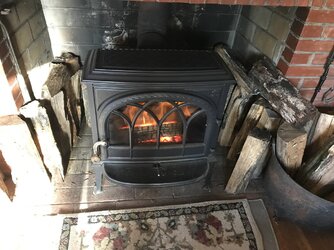There was mention of a 60°C threshold in the name of avoiding pyrolysis, in another thread, which is about 140°F by my figuring. Having been working on my boiler a bit this week, I notice it's set to run up to about 230°F when there's a call for heat. That's internal boiler temperature, and actual water temperature to the radiators will come in below that, depending on flow rate etc.
I decided to fire one zone and check surface temperature on the pipes (copper tubing) leading from the boiler to that zone, and it's measuring 100°C ± 10°C. This tubing penetrates several floor joists up to 300 years old, and is captured between 250 year old flooring and an insulated ceiling in a few cases, pressed directly against the underside of the flooring.
I believe this is typical, business as usual for the tens of millions of oil- or gas-fired hydronic systems that were the norm in this country for decades, and continue to be used in existing homes. But if 60°C is a threshold for concern, then this is something to which we might give more attention.
I decided to fire one zone and check surface temperature on the pipes (copper tubing) leading from the boiler to that zone, and it's measuring 100°C ± 10°C. This tubing penetrates several floor joists up to 300 years old, and is captured between 250 year old flooring and an insulated ceiling in a few cases, pressed directly against the underside of the flooring.
I believe this is typical, business as usual for the tens of millions of oil- or gas-fired hydronic systems that were the norm in this country for decades, and continue to be used in existing homes. But if 60°C is a threshold for concern, then this is something to which we might give more attention.





